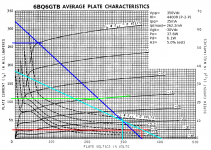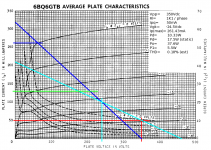Folks,
I'm playing with the bias of a 300B and am quite surprised that even small changes in the operating point seem to make a big difference in the sound quality. I'm wondering what makes the difference.
I'm running a 300B SET amp of my own design. It's heavily inspired by Tubelab SE.
Basically, the design consists of a regulated B+ and bias supply followed by a couple of 6J5's driving the 300B through a source follower. I'm using the Edcor CXSE25-8-5K OPTs. I get roughly 1 % THD at 1 W, 3 % THD at 5.4 W.
385 V B+, 60~70 mA sounds awful. Very harsh and strained. This may be due to my supply operating with minimum headroom at this output voltage. 370~375 V, 70 mA sounds very good but the highs are a bit muddy. 370 V, 60 mA seems to be the sweet spot.
Has any of you observed something similar? Any idea what causes this? Does the different operating points result in a different distribution of the harmonics? The total THD+N is roughly the same (lower at higher currents). I could of course just drag the amp upstairs and throw it on the spectrum analyzer, but I wonder if someone else has already done the work.
~Tom
I'm playing with the bias of a 300B and am quite surprised that even small changes in the operating point seem to make a big difference in the sound quality. I'm wondering what makes the difference.
I'm running a 300B SET amp of my own design. It's heavily inspired by Tubelab SE.
Basically, the design consists of a regulated B+ and bias supply followed by a couple of 6J5's driving the 300B through a source follower. I'm using the Edcor CXSE25-8-5K OPTs. I get roughly 1 % THD at 1 W, 3 % THD at 5.4 W.
385 V B+, 60~70 mA sounds awful. Very harsh and strained. This may be due to my supply operating with minimum headroom at this output voltage. 370~375 V, 70 mA sounds very good but the highs are a bit muddy. 370 V, 60 mA seems to be the sweet spot.
Has any of you observed something similar? Any idea what causes this? Does the different operating points result in a different distribution of the harmonics? The total THD+N is roughly the same (lower at higher currents). I could of course just drag the amp upstairs and throw it on the spectrum analyzer, but I wonder if someone else has already done the work.
~Tom
Hi!
This is probably controversal because my opinion and experience is probably different from the common belief.
I think in a good design small changes of the operating point should not cause the sound to change. If that is the case that indicates that something is working at it's limits. Either some component ist stressed/reliefed depending on the change or (more Likely) as you mentioned the THD spectra of the various stages add up differently and cause audible changes. The latter indicates lack of headroom.
When you have signal on your amp, the output tube will move through a range ofoperating points. If a change in op point is very audible that means the amp will amplifiy the positive and negative halfs of the wave differently. Something you don't really want.
I built my amps such that I can change the op point in the output tube by a wide margin without significant changes in sound. This is achieved (among other things) by a driver with large headroom. I shoot for 12dB minimum headroom.
Best regards
Thomas
This is probably controversal because my opinion and experience is probably different from the common belief.
I think in a good design small changes of the operating point should not cause the sound to change. If that is the case that indicates that something is working at it's limits. Either some component ist stressed/reliefed depending on the change or (more Likely) as you mentioned the THD spectra of the various stages add up differently and cause audible changes. The latter indicates lack of headroom.
When you have signal on your amp, the output tube will move through a range ofoperating points. If a change in op point is very audible that means the amp will amplifiy the positive and negative halfs of the wave differently. Something you don't really want.
I built my amps such that I can change the op point in the output tube by a wide margin without significant changes in sound. This is achieved (among other things) by a driver with large headroom. I shoot for 12dB minimum headroom.
Best regards
Thomas
Thomas,
As the operating point moves, the THD of the output stage should change. This is fairly easy to show by plotting identical load lines (in my case 5 kOhm) on the anode curves and looking at the variation in anode voltage for a given variation in grid voltage as function of operating point. I've never seen a tube where that was not the case. The question is how much the THD affects the sound quality -- if that is indeed the factor that determines sound quality.
I do agree that if something is running out of headroom, the sound quality will suffer. That's what I think happened when I pushed the supply voltage too high.
~Tom
As the operating point moves, the THD of the output stage should change. This is fairly easy to show by plotting identical load lines (in my case 5 kOhm) on the anode curves and looking at the variation in anode voltage for a given variation in grid voltage as function of operating point. I've never seen a tube where that was not the case. The question is how much the THD affects the sound quality -- if that is indeed the factor that determines sound quality.
I do agree that if something is running out of headroom, the sound quality will suffer. That's what I think happened when I pushed the supply voltage too high.
~Tom
Hi Tom,
yes the THD of the output stage will change, but that should only matter for close to full power output. For the average listening levels it should not really matter. If it does, maybe the speakers are not sensitive enough and do not match well with the amp.
Best regards
Thomas
yes the THD of the output stage will change, but that should only matter for close to full power output. For the average listening levels it should not really matter. If it does, maybe the speakers are not sensitive enough and do not match well with the amp.
Best regards
Thomas
I have had experiences of some 300B models working best at 350V & 60 to 70mA. high voltage seem to increase the glare, and make them sound stressed.
Outside the 300B, the first place to look is the power supply. Higher operating points stress the rectifiers harder, making the HF thrown back into the transformer worse. Do you have some tuned RC snubbing across the secondary?
With regulated B+, the regulator transients will behave very differently as output voltage goes up. How does the regulator respond to step loads?
Outside the 300B, the first place to look is the power supply. Higher operating points stress the rectifiers harder, making the HF thrown back into the transformer worse. Do you have some tuned RC snubbing across the secondary?
With regulated B+, the regulator transients will behave very differently as output voltage goes up. How does the regulator respond to step loads?
The classic sweet spot as documented in the Western Electric catalog was 360V @ 60mA.
What is this "classic sweet spot"?
The best sounding operating point?
Western Electric was a bit more in theatre amplification than in high end tube audio at the time. Maybe their 360V/60mA operation point had more to do with life expectancy of the tubes, and the difference between 7 or 9 watts of max output power is not that important with respect to the high efficiency theatre loudspeaker systems.
After all the max plate dissipation for the 300B is specified as 40 watt (WE 1950 spec is 36 watt). So in normal practice the operating points should allow a 30 watt plate dissipation instead of the 22 watt (360V/60mA) without problems, and I doubt that there is only one ww watt sweet spot.
I very much agree with Thomas that headroom might play a very important role here. The typical SE amplifier consists of power supply, input/driver stage and output stage (output tube + OPT). I even dare to say that the 300B is not the dominant player with it's gain of about 3 in a normal circuit. Assuming that all parts of the amplifier are up to their task there should be a wider range of good sounding operating points for the 300B alone.
Loudspeakers are very important too of course when driven by SE amps. A friend of mine recently discovered how much better his 300B amp played when he switched his 95 dB speakers for Klipsch Lascala's.
Folks,
I'm playing with the bias of a 300B and am quite surprised that even small changes in the operating point seem to make a big difference in the sound quality. I'm wondering what makes the difference.
I've seen that happen before: with a project that uses 6BQ6GA/GTBs as PP finals. The original design called for: Vpp= 350Vdc with a bias of 25mA per final. That gives a Pd= 8.75W, safely under the rated Pd= 12W. That sounded OK, but busting the spec by running the bias up to 50mA/final (Pd= 17.5W) definitely helped the sonics. Loadlines tell the tale (attached). Running hotter greatly reduces the THD, and the 6BQ6GA, being a TV horizontal deflection type (no audio use specified in the spec sheets at all) has very conservative ratings, so this spec-busting does no harm. (BTW: These sound really good -- much like the famous 6V6, but with over twice the output capability.)
With a 300B SET, I would suspect OPT issues. A slight change in bias can mean a difference of many amp-turns in core magnetization. That just might account for the differences you hear, and would especially apply if you're not including any gNFB, which leaves your performance at the absolute mercy of the external circuitry and passive components.
Attachments
- Status
- This old topic is closed. If you want to reopen this topic, contact a moderator using the "Report Post" button.
- Home
- Amplifiers
- Tubes / Valves
- 300B Sweet Spot

